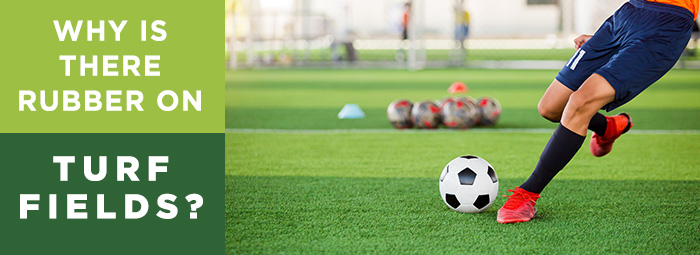
If you’ve ever been a spectator or a player in a game of soccer or another high intensity field sport like football or baseball, you may have noticed a kind of rubber dust getting kicked up. Why is there rubber on the field? How did it get there? You were most likely at an artificial turf field, and you were probably noticing crumb rubber.
What is crumb rubber?
The rubber on turf fields is usually crumb rubber, an infill for artificial turf that’s used to create cushion and keep the field ready for activity. It is created from ground-up recycled tires and is the most economical infill option you will find. Crumb rubber is top dressed over a sand ballast and can be installed with a shock pad for added assurance but is not required.
It is the most common infill option for synthetic turf sports fields. You can use crumb rubber infill for a number of surfaces:
- Golf courses
- Baseball and softball fields
- Football fields
- Soccer fields
- Field hockey fields
- Lacrosse fields
- Pet areas
- Playgrounds
- Recreational areas
- High-traffic lawns
- Indoor facilities
While inexpensive and giving a feel that is similar to natural grass, it retains heat, can be messy, and some people find the smell unpleasant.
What is Infill?
Infill is granules of material that you distribute between the blades of artificial turf. Infill weighs it down, protects it from damage, and gives the turf the appearance and feel of natural grass.
- Supporting Grass Fibers: Field turf relies on its infill to support and protect each fiber of grass.
- Maintaining Dimensional Stability: Infill keeps turf upright by allowing blades to stand up and stay up.
- Adding Volume: Athletic fields must have sufficient cushion and bounce, and turf infill adds volume to the top layer of turf while providing a substitute for soil, sand, clay, and other natural ground materials that may be sparse on your field.
- Simulating Soil: If your athletes play on natural grass but practice on turf or vice versa, it’s very important to simulate the bounce and texture of natural grass.
- Cooling: Synthetic turf may attract excess heat without the benefits of UV-resistant infill, such as acrylic-coated sand that prevents the absorption of solar energy.
Infill also helps with liquid drainage, while also providing antimicrobial protection to prevent mold and fungal growth and the spread of infectious bacteria and viruses.
Types of Turf Infills
In addition to crumb rubber there are many different types of infill materials, and all of them have specific uses and functions.
Sports Infills
Crumb rubber and sports infills are commonly used for turf sports fields like soccer, football, and baseball fields. Depending on the climate and quality of infill desired, there are many different types to choose from. A combination of coated sand and crumb rubber is a common choice for cushioning and low cost.
Landscaping & Pet Infills
Crumb rubber and silica sand are useful for athletic sports fields, as well as outdoor home or property applications, such as landscaping turf and pet turf. Crumb rubber is less common on residential lawns, but is a good choice for high-traffic areas and recreational areas.
Playground Infill
Playgrounds can be a bit rough and tumble, so infills like crumb rubber cushion the occasional crashes and burns that children at play have on playground turf. For this, we recommended anti-microbial round sand with padding underneath the turf. This will protect kids both from accidents and other icky things. Crumb rubber is a common choice for playground turf for its affordability and shock absorption. However, we recommend it for cooler climates since it retains heat.
Cooling Infills
In hot climates like Arizona, turf lawns and sports fields with crumb rubber can retain heat. Luckily, there are methods to help keep turf cool, such as cooling infills, like T°Cool. This treated sand infill is designed to capture water and dew in the cooler hours of the day, evaporating later as the sun heats it, similar to how grass transpires and cools the surrounding air, or the body perspires to cool itself.
Alternatives to Infill
Some turf doesn’t need infill. For example, batting cages and other multipurpose indoor facilities may have turf with nylon thatch. SportMax and other multipurpose, indoor turf products are mixed with this artificial thatch to improve durability and simulate the padding of real soil. Depending on the sport and your maintenance budget, these can be cheaper alternatives to infill.
For putt putt courses or putting greens, Poly Putt and other putting green turfs have urethane backings that are designed for sand-filled surfaces. Infill isn’t necessary to cushion these products, and with the right maintenance, they’ll last a long time.
Picking the Right Infill
Artificial turf is a rare improvement on nature— offering better hygiene, water and drought resistance, cushioning, color, and consistency than natural grass. However, your infill selection will ultimately determine the overall effect of your turf. Athletes depend on infill to support and protect them. Infill must also simulate the natural fields for both comfort and drainage.
Turf Factory Direct for All Your Turf Needs
If you’re curious about artificial turf, or are considering investing in it, Turf Factory Direct has you covered. Our helpful and knowledgeable staff is ready to answer any questions, and we have turf for batting cages, sports fields, playgrounds, pets, soccer fields, and so many other applications. Get in touch with us or start browsing our products today.








